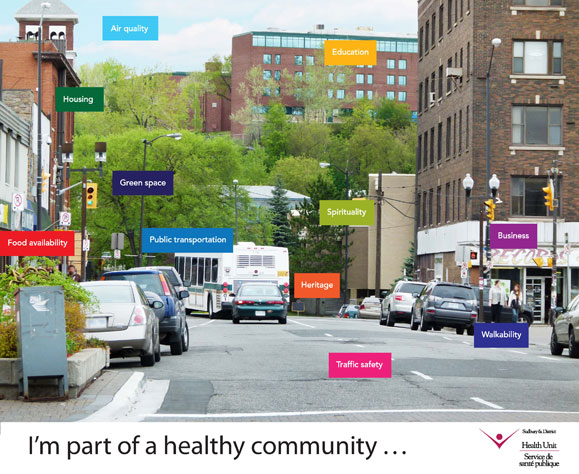Sudbury and District Health Unit
Changing public health practice to reduce social inequities in health

It's been a journey of more than a decade for the Sudbury & District Health Unit (SDHU) in its move towards a health equity approach in public health practice. Supported by a 10-year strategic vision that includes milestones and evidence-based action plans, SDHU has made significant organizational and structural changes to better address the social determinants of health.
Health Equity Office (HEO) Manager Stephanie Lefebvre described to CPHA the local event that catalyzed SDHU's transformation: the 2001 death of Kimberly Rogers. Ms. Rogers was a 40-year-old Sudbury student who was eight months pregnant when she died in August 2001 while under house arrest for welfare fraud. Her crime was to receive $13,500 of annual social assistance while concurrently receiving student loans to enable her to study social work.
Ms. Rogers' death resulted in a province-wide debate and coroner's inquest in 2002 during which Medical Officer of Health Dr. Penny Sutcliffe testified about the direct relationship between living in poverty and poor health. She provided local data about the cost of nutritious eating in Sudbury, amounting to $140 per month for a single person in that city. The inquest heard that Ms. Rogers would not have had $140 for food after paying her rent and other expenses such as transportation, utilities, and clothing. The coroner recommended that such local data be used routinely to assess whether social assistance rates are sufficient to meet recipients' basic needs.
Why we do what we do
Ms. Rogers' death marked a turning point for the SDHU.
"It was a clear and tangible example of the tragic health impacts of not having access to social and economic resources. ...It galvanized our internal efforts in advocacy and in restructuring the way we work. ...It [gave] us permission and ground[ed] us in the reason why our continued social determinants of health work was just as important as the more traditional work we do," Ms. Lefebvre said.
SDHU's contribution to the inquest demonstrated the important upstream role to be played by public health in both reducing poverty rates and mitigating the health repercussions of poverty and social inequities. All subsequent work by the unit has been inspired by this example of healthy public policy advocacy and development through the provision of local evidence.
Multidisciplinary and intersectoral approach
The multidisciplinary HEO team work with staff and management across the health unit and multiple sectors within the community to coordinate health equity efforts.
"We mapped our own work... assessed our activities... and their potential to increase or decrease health equity in the community," Ms. Lefebvre explained.
As a result, health unit staff saw what effects they were having in various population groups and the synergies that had developed across programs; information that helped them improve and fine-tune their work. Now, HEO raises community awareness of social determinants through social marketing and coordinates pilots of intersectoral and equity-focused health impact assessments with community agencies, liaising closely with partners such as the police department, the city, school board, social planning council, community health centres, mental health groups, Aboriginal organizations, francophone agencies, youth-focussed support services, hospital, etc.
"Rather than look at our health data in isolation, we're partnering for a broader range and richness of discussion.... They are interpreting [the data] with us," said Ms. Lefebvre.
As a result, opportunities for joint work grow. "Police services are looking for intersectoral models for 'community safety' ... which we're focussing on as 'community well-being' to address immediate risk factors and underlying root causes of the issues we're seeing."
HEO helps staff and external agencies develop organizational and community-based vision statements that contain goals for organizational culture, competencies, partnerships and community engagement. Its "evergreen" 10-Year Sequential Action Guide to Achieve the SDHU Health Equity Vision identifies the specific efforts, resources, and supports needed to achieve its vision and is based on actions that reflect evidence-based, promising practices to reduce social inequities in health - an approach that is applicable to other jurisdictions.
These efforts have brought everyone - individual staff members, leadership teams, the board and executive team - into the process of transformation to integrate the social determinants of health approach. SDHU's success to date is a testament to the commitment and passion of all those involved in identifying and mitigating the root causes of ill health in the Sudbury community.
Taking an organizational approach, the SDHU has implemented the following initiatives:
- Opportunity for All: The Path to Health Equity
Opportunity for All describes the link between health and social and economic environments in the City of Greater Sudbury. Building on a growing evidence base about the relationship between health and socio-economic factors, this report presents an analysis of 15 health indicators by area deprivation in the City of Greater Sudbury and finds that health inequities exist. Opportunity for All assesses the impact of these inequities in the City of Greater Sudbury and highlights some key considerations for the City's path to health equity. - 10 Promising Practices to Guide Local Public Health
As part of a Canadian Health Services Research Foundation research fellowship (2008-2010), the Sudbury & District Health Unit identified 10 public health practices that are "promising" in their potential to reduce social inequities in health at the local level. - Health equity resources
The SDHU has developed a number of resources to help inform health equity action. These resources include Let's Start a Conversation About Health... and Not Talk About Health Care at All, a 5-minute video highlighting that HEALTH is about more than access to medical care. It highlights that everyone has different opportunities for health. The video describes actions that people and organizations can take. This section also includes references to other SDHU and external resources.




